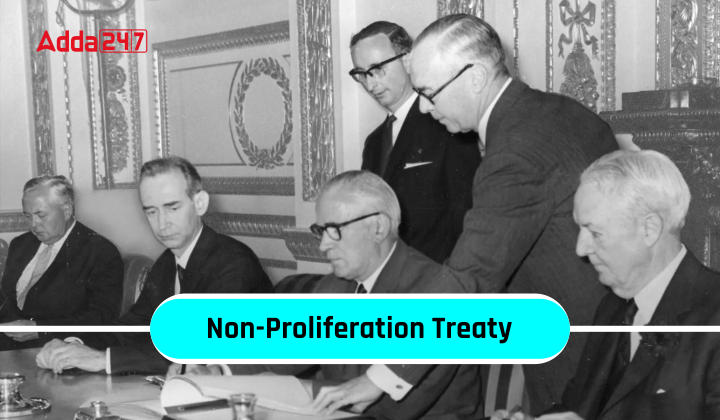Table of Contents
The Non-Proliferation Treaty (NPT) is a worldwide agreement that tries to stop nuclear weapons and their technology from spreading. It also encourages countries to use nuclear energy peacefully and aims to get rid of all nuclear weapons eventually. In 2020, the NPT celebrated its 50th anniversary since coming into force. Understanding the Non-Proliferation Treaty is crucial for aspirants of the IAS Exam, particularly for the section on current affairs, which holds significance for the Mains GS-II (International Relations & Multilateral Agreements) examination.
Non-Proliferation Treaty
- The Non-Proliferation Treaty emerged from the efforts of the Eighteen Nation Committee on Disarmament, a UN-backed group headquartered in Switzerland. The NPT seeks to restrict the proliferation of nuclear weapons and encompasses three key components: Non-Proliferation, Disarmament, and the Peaceful Use of Atomic Energy.
- Its roots trace back to the tragic events of August 6th and 9th, 1945, when the United States dropped atomic bombs on Hiroshima and Nagasaki, concluding World War II at a devastating cost. The bombings resulted in between 129,000 to 226,000 casualties across both cities, with many more suffering from radiation-related illnesses.
- The aftermath of these bombings raised serious concerns among global powers about the potential misuse of nuclear weapons and their long-term effects. In response, there were calls for measures to prevent a nuclear arms race. In 1961, a UN resolution initiated the process of drafting a treaty to address these concerns, eventually leading to the creation of the Non-Proliferation Treaty.
Who signed Non-Proliferation Treaty?
The Non-Proliferation Treaty, operational since 1970 following its opening for signing in 1968, boasts 187 participating nations. Its core objective is to prevent non-nuclear states from acquiring nuclear arms and prohibit nuclear powers from assisting others in obtaining such weapons.
Oversight of compliance lies with the International Atomic Energy Agency, the successor to the United Nations Atomic Energy Commission, with enforcement handled by the United Nations Security Council. Nine countries currently have nuclear weapons. Among them, the United States, United Kingdom, France, Russia, and China have signed the treaty. However, India, Pakistan, Israel, and North Korea have not signed it and are not part of the treaty.
Member of Non-Proliferation Treaty
- 191 countries are part of the NPT, with 5 among them possessing nuclear weapons, making it the most extensive arms control agreement.
- The NPT prohibits non-nuclear states from obtaining nuclear arms and prohibits nuclear states from assisting others in acquiring them.
- The treaty strives for total disarmament.
- Among the 9 nations with nuclear capabilities, 5 (the US, France, the UK, Russia, and China) are signatories to the NPT.
- India, Israel, Pakistan, and North Korea have not signed the NPT.
Role of States Under NPT
The roles of states are outlined as follows:
- Nuclear Weapons States are prohibited from transferring nuclear weapons to any recipient and from encouraging Non-Nuclear Weapons States (NNWS) to produce or obtain them.
- Non-nuclear weapons states are barred from receiving nuclear weapons from any provider and are forbidden from producing or obtaining them.
- Non-Nuclear Weapons States (NNWS) must agree to International Atomic Energy Agency (IAEA) safeguards for all nuclear materials.
Drawback of NPT
The Non-Proliferation Treaty faces significant criticisms. So here are some drawbacks of the Non-Proliferation Treaty (NPT) below:
- Firstly, it didn’t hold accountable the five nations possessing nuclear weapons when it was signed.
- Additionally, its enforcement is questionable; North Korea’s nuclear test in 2006 and Iran’s potential nuclear program highlight this.
- The treaty contains loopholes that could be exploited by other countries to develop their nuclear weapons.
- Despite these drawbacks, the Non-Proliferation Treaty has made the world safer. Initially, it was feared that around 25 nations might acquire nuclear weapons, but the actual number is nine, partly due to the treaty’s influence.
- While the NPT alone isn’t responsible for this reduction, its existence promises a more peaceful era. Addressing its current shortcomings could further enhance this promise.
Issues of Non-Proliferation Treaty
Here are the key concerns associated with the Non-Proliferation Treaty:
- Effectiveness of the Treaty: Doubts linger regarding the NPT’s efficacy in preventing nuclear proliferation.
- Obligations of Nuclear-Weapon States: There are doubts about whether nuclear-weapon states are fully committed to the disarmament process mandated by the NPT.
- Concerns of Non-Nuclear Weapon States: Some non-nuclear weapon states feel that nuclear-armed nations are not sufficiently reducing their nuclear arsenals.
- Slow Disarmament Progress: Progress toward complete disarmament is perceived as sluggish, raising significant concerns.
- Universality of the Treaty: The NPT’s global applicability is questioned due to the absence of participation from all countries.
- Nuclear Testing Challenges: Despite being NPT signatories, some nations have conducted nuclear tests, challenging the treaty’s effectiveness.
- Withdrawal Implications: The withdrawal of certain countries from the NPT has sparked concerns regarding the treaty’s stability and influence.
- Addressing Emerging Technologies: The NPT must adapt to address new nuclear technologies, leading to uncertainties about their regulation.
- Impact of Regional Security Dynamics: Regional security concerns may influence countries’ adherence to the principles of the NPT.
- Challenges in Compliance and Enforcement: Ensuring adherence to the NPT’s provisions remains a persistent challenge.



 TSPSC Group 1 Question Paper 2024, Downl...
TSPSC Group 1 Question Paper 2024, Downl...
 TSPSC Group 1 Answer key 2024 Out, Downl...
TSPSC Group 1 Answer key 2024 Out, Downl...
 UPSC Prelims 2024 Question Paper, Downlo...
UPSC Prelims 2024 Question Paper, Downlo...
